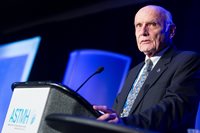
Scott B. Halstead, MD, FASTMH, Past President of ASTMH, is one of the world’s foremost authorities on viruses spread by mosquitoes, including dengue, Japanese encephalitis and chikungunya, and was the first to describe the phenomenon known as "immune enhancement" associated with dengue infections, in which antibodies against one type of dengue virus could “enhance” a later infection by a different strain, leading to a deadly hemorrhagic fever. In 1990, while with the Rockefeller Foundation, Dr. Halstead co-founded the Children’s Vaccine Initiative. He was President of ASTMH in 1991 and in 2017 received the Society’s highest honor, the Walter Reed Medal (photo left).
This month,
Scientific American featured Dr. Halstead prominently for an article about the dengue vaccine Dengvaxia, along with past President Duane J. Gubler, ScD, and former Councilor Eva Harris, PhD. We decided to use this opportunity for a short member Q&A with Dr. Halstead:
What is it about dengue that intrigues you?
Dengue is completely different from all other human viral diseases. The history of the discovery of other diseases usually ends when the virus and the means of transmission are discovered. But with dengue, the discovery that severe disease accompanies a second, not a first infection meant that research was just beginning. Investigations uncovered a whole new form of human immunopathology, and close attention to disease has revealed that dengue is a toxicosis, an analog of the bacterial toxic shock syndrome. We still have a long way to go to understand how antibody dependent enhancement works.
In your view, what have been the turning points in dengue research during your career?
- Discovery that severe dengue accompanied a second (not a third or fourth) dengue infection and, in infants, circulating antibodies acquired from two or more dengue infections.
- Discovery of enhanced growth of dengue viruses in monocytes/macrophages, in vitro and in vivo, in the presence of non-neutralizing dengue antibodies.
- Discovery that T cell immunity is crucial to immune protection against dengue virus infection.
- Discovery that the dengue non-structural protein, NS1, directly damages capillaries, causing vascular leak and making dengue a deadly disease.
The scientific community seems to agree that climate change is a serious threat to health. How do you see climate change impacting dengue?
It is very discouraging to see and hear opinions that climate change is partially responsible for the 20th-21st Century dengue pandemic. This is simply not true. Indeed, the widest geographic distribution of Aedes aegypti and dengue viruses historically occurred during the Little Ice Age in the 1700s, with outbreaks in Northeast America. Global dengue is due to very modern factors, growth of population, growth of cities, lack of piped water, high speed travel and failure of vector control programs.
International collaboration has always been at the heart of tropical medicine research. What do you see as some of the greatest strengths of international collaboration?
Dengue transmission occurs in virtually all countries in the tropical zone with little direct involvement of the continental United States. So, research on dengue that involves studying the disease in humans and the mechanism of transmission is an international collaboration. Several of the finest international collaborative laboratories in the world have been established at least in part to study dengue: the Armed Forces Research Institute of the Health Sciences in Bangkok, Thailand; the Oxford Vietnam Research Laboratory in HoChiMinh City; NAMRU 2 in Jakarta, Indonesia; and NAMRU-6 in Lima, Peru.